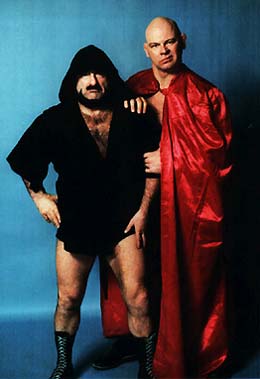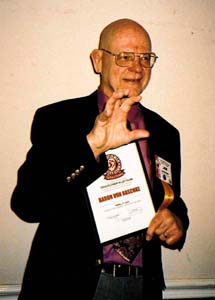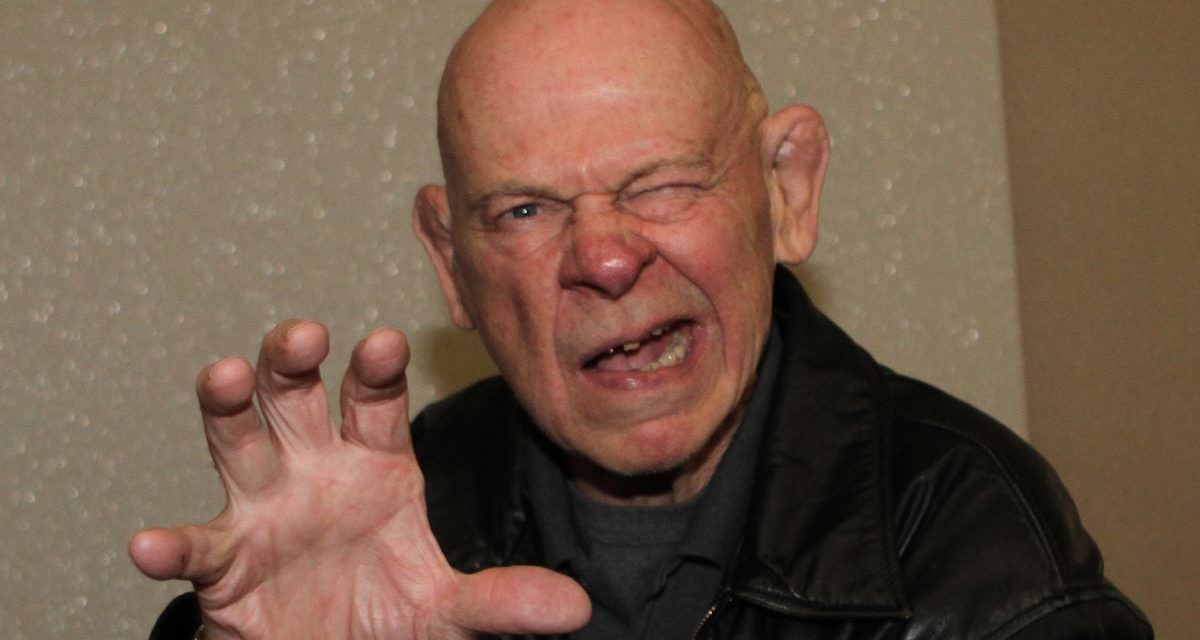“Jimmy Raschke, from Nebrasky” is how he introduces himself at the beginning of his interview with SLAM! Wrestling, but one look at the man belies this modest self-description. The six-foot-four frame, completely shaved head, cauliflower ears, massive hands, and multiple scars tells a different story: He was a wrestler. In fact, he was one of the best.

Mad Dog Vachon and Baron von Raschke in the Montreal-based Grand Prix Wrestling.
Known to professional wrestling fans across the globe as Baron Von Raschke, Jim Raschke was also one of the finest amateurs of his era, a heralded student athlete with high school and college championships catapulting him into an Olympic career as a Greco-Roman wrestler. After that, life as a teacher in the Minneapolis Public Schools seemed satisfying enough, until something inside moved him in a different direction. A direction he never would have imagined he’d be heading. Professional wrestling …
“I never felt positive about professional wrestling,” he says of his earliest days as a fledgling pro. “I’m a very shy person, and it was hard for me to even make my initial contacts with Joe Dusek, Verne Gagne and Wally Karbo.” Breaking into the sport in the kayfabe era of 1966 meant being brought along slowly, facing numerous tests before doors were opened and secrets revealed. “I went to Verne Gagne’s office, and I was told, ‘Come back tomorrow, nobody’s here.’ It took maybe five or six days before I met Wally Karbo. Wally would make up all kinds of strange stories about Verne not being there.”
Raschke was persistent, however, and kept showing up at the office of the legendary Verne Gagne, who was impressed by Raschke’s amateur credentials, and agreed to become his trainer. “It took about two weeks before I even met Verne. He said, ‘You can come out to the barn.'”
“The Barn” was located on Gagne’s farm, just west of the Twin Cities, where he trained dozens of top-flight pro wrestlers, such as three Anderson “brothers”, Lars, Ole, and Gene, and, later, Ricky Steamboat, and Ric Flair.
Even with the lucky break of being accepted into Gagne’s training camp, life was not easy for Raschke, who was struggling financially. “I had just gotten out of the army, and I was running out of money. I taught school, but I got out of teaching early so I could be on the World Team in ’65,” he says. Living on his earnings as a substitute teacher, when he entered Gagne’s training camp, Raschke says, “I was just about broke. I started to work out, and after four or five weeks, Verne started to smarten me up, as they say in the business. And he gave me a job setting up and tearing down the ring. I refereed matches, and picked up money from the small towns and brought it to the office. It was tough.”
Watching Baron Von Raschke at the height of his career, no one would guess that he questioned his involvement in the business because of a fear of public speaking. As a world-class athlete, Raschke was able to handle the physical training necessary to become a professional, but developing his persona and interview skills was a different story. “Being a professional wrestler, you have to speak, and do interviews. Oh! Public speaking? No way! I didn’t think I could do that! My first interviews when I was starting out were with [veteran AWA announcer] Marty O’Neill, and I was just horrible, probably the worst ever. Marty did two or three of these interviews with me, and he was a very tolerant guy, but he went to Verne Gagne and said, ‘Verne! You’ve got to get that kid to speak up!’ I couldn’t make myself do that. And then, I met the Mad Dog. Are you ready for ‘the Mad Dog Story?'”
Raschke’s eyes sparkle as he tells the story of how he first met future mentor Maurice “Mad Dog” Vachon, or, more accurately, how Vachon met him.
“I was at the television studio, sitting in the control room, watching how they did things, and Mad Dog stuck his head in and said ‘You would make a good German!'” This continued for a while, and after the conversations became less one-sided, Mad Dog asked Raschke to join him in Montreal as his tag team partner. “There was something there,” Raschke says. “We were both amateur wrestlers, and we’d both been on Olympic teams, so we shared a common bond.” With that, Raschke and his wife Bonnie moved to Montreal. “We packed up our little red Mustang,” he says, “and we drove up to Canada. I still didn’t think this wrestling thing was going to work, but, I thought, ‘I’m going to try.'”
The first night Raschke teamed with Mad Dog, Vachon told him, “Just do what I do!” “People didn’t like us,” Raschke points out. “The combination just clicked automatically, and boosted my confidence.” Under the hairy wing of Mad Dog Vachon, Raschke began to transform, and his personality blossomed. “Once I became Baron Von Raschke,” he grins, “I could do interviews. I could talk in front of cameras. I could do anything I wanted.”

Jim Raschke is honoured at the 2004 Cauliflower Alley Club reunion in Las Vegas. Photo by Rose Diamond
Along with following Mad Dog’s lead, Raschke feels that he was also emboldened by the fact that we was in a totally new place, where no one was likely to know him from his amateur days. The difference in language helped, too. “I was up there in a French-speaking country, so I figured, ‘They aren’t going to understand me anyway,’ and I practiced pronouncing words in a German accent to sound more authentic.” This new sense of freedom allowed Raschke to develop his considerable interview skills, which would be an asset throughout his career.
As it turns out, Canada is not only the birthplace of the Baron Von Raschke character, but it’s also the first place he ever “juiced,” or bled in a match. Kayfabe still courses through Raschke’s veins, but in a SLAM! exclusive, he told the story of his first encounter with the blade. “My first experience blading was with Johnny Rougeau; they wanted juice on me. I had never done that before, and didn’t really care to, so, Johnny says, ‘It’s alright, I’ll do it for you.’ Johnny makes his big comeback, and, the next thing I know, I was bleeding out of my neck, my arm, about five places! Every place but where I was supposed to be! He had the blade on his finger, and the tape had come off. So, that was my first experience with the blade. And I did it myself after that!”
After the birth of the wrestler who eventually became known as simply “The Baron,” Raschke worked nearly everywhere, including St. Louis, for Sam Muchnick. A memory that stands out from that territory is meeting Bobby Heenan, for the first time. “I wear glasses, and can’t see too well without them. I had never worked in Kiel Auditorium, and I took my glasses off to go to the ring. I ended up going out the wrong door, and I had to walk through the crowd. Without my glasses on, I had to kind of feel my way to the ring. Once I climbed up into the ring, I tripped over my robe. Heenan, who was with Blackjack Lanza at the time, thought it was just hilarious. Those guys liked any kind of a joke or funny story.” After the match, Heenan’s ribbing of Raschke over his painstakingly difficult path to the ring began a friendship that endures to this day. “Bobby was always fun to travel with, and a very funny guy. I’ve always liked him.” Another positive attribute Raschke remembers about Heenan was his dedication to his family, as he used his wrestling earnings to support his grandmother and his mother.
Raschke also made a friend in a rookie Dusty Rhodes. “Dusty had just started in the business and we were working for the Detroit office, for the Original Sheik, Eddie Farhat. Dusty came in, and he had no money. He’d been a semi-pro football player. We got to know each other on a plane. He didn’t have a place to stay, so he and his new wife stayed with my wife and I in our trailer for a while. We were good friends.”
Raschke’s wife, Bonnie, who laughed at the memory of meeting a young Rhodes for the first time, said, “He was nuts! He came to our trailer in February in flip-flops!”
When asked what The Sheik was like to work for, Raschke says, “I worked for Eddie Farhat after Montreal. These were my early years, and I didn’t know any better so I thought it was great. Actually, Sheik had a reputation as not being a very good payoff guy, but he took good care of me.”
Raschke also challenged Bruno Sammartino for the WWWF title while working for Vince McMahon the Elder. Raschke remembers Sammartino as “a tremendous person. He has high morals, and he’s a person of good character. He did a lot for a lot of guys in the business, and he was a good friend to a lot of people. Bruno was so good [as a worker] that I never even noticed how strong he was. He never tried to impress me in the ring with his strength. We were out there to do something for the people and that’s what we did. Bruno was really very good at it. I like him.”
The Baron eventually returned to Minnesota, and the AWA to avenge his former partner Mad Dog Vachon, who had been injured by AWA superheel Jerry Blackwell, when a strange thing happened: the fans began to cheer for the previously-hated Raschke. This switch was not planned, but the people spoke; Baron Von Raschke became their hero. He explains, “You needed evil to fight evil. The longest known evil is better than the newer evil, so the fans were on my side.” He recalls the massive Blackwell, billed as “The Mountain from Stone Mountain,” as “great to work with. He was a strong guy who could run, and jump. He was a good athlete, in control of his body, and a great worker in the ring.”
Another superstar Raschke has fond memories of working with is the Immortal Hulk Hogan, with whom he teamed for a number of matches in the AWA during its heyday in the early ’80s. “Hulk had the kind of interview that attracted young people, and he had charisma. He was a big physical specimen and he looked good.”
The Baron also crossed paths with Jesse “The Body” Ventura in the AWA. Raschke harbors no ill will towards the former governor of Minnesota for nicknaming him “E.T.” during their AWA feud, however. “Jesse was an excellent talker, and he did a lot of ‘show business’ type things, which he was very good at.”
Raschke also has a special place in his heart for a worker who lost on AWA television nearly every week, legendary enhancement talent Kenny “The Sodbuster” Jay. “Kenny’s got a lot of heart, to keep coming back after getting beat every week,” Raschke joked. “Kenny was a pleasure to work with, and he was always willing to do anything. He could do anything, by the way. He was great in the ring, and his work was very, very good. He took care of his family, and had the landscaping business. Wrestling was a side job for him. Kenny’s one of my favorite guys. I love Kenny.” (In fact, The Baron recently returned from Northfield, MN, where he attended Kenny Jay’s annual histiocystosis fundraiser.)
Now retired, living with his wife, Bonnie, in southern Minnesota, the Baron has few regrets when reflecting on a career as one of professional wrestling’s most memorable characters. His legacy is ensured after his 2002 induction into the George Tragos/Lou Thesz Professional Wrestling Hall of Fame in Iowa. “I liked what I did, and I always liked going to work,” he says.
The people in the region seem grateful he did. During a visit to a local restaurant for lunch, everyone looked up and smiled when the wrestler known as The Baron walked in. Some pointed, and others whispered, but they all remembered. And as Baron Von Raschke himself would say, “That is all you need to know!”
TOP PHOTO: Baron Von Raschke by George Tahinos.
RELATED LINK

